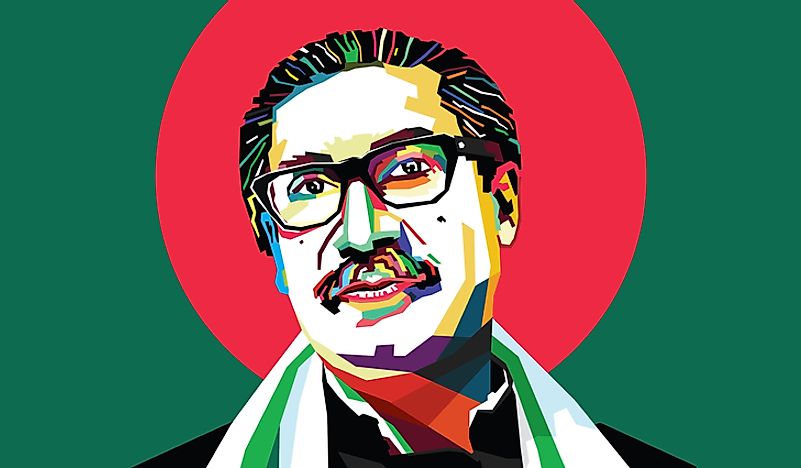Presidents Of Bangladesh

The Parliament selects the President of Bangladesh, who, in turn, appoints several top government positions. The Constitution of Bangladesh guarantees the President a high degree of immunity, as they are not answerable to anyone for his action except the parliament that can impeach them. The President also has the power to refuse to assent any bills passed by the house. However, in contrast to many republics around the world, the Bangladeshi Presidency is more of a ceremonial position, and can only act on the directive of the Prime Minister and the Cabinet. The President can only serve one single term in a lifetime.
Sheikh Mujibur Rahman
Sheikh Mujibur was the first President of Bangladesh. He came to power in 1971 when the country was called East Bangladesh. In 1972 he was captured and imprisoned in Bangladesh, his deputy took over as acting President. He became President again in 1972 after his incarceration.
Rahman introduced the state policies of nationalism, democracy, secularism, and socialism. He is credited with rescuing after the economy was ravaged with war. His government focused on rehabilitation, relief, and reconstruction of the failing economy. In 1974 he declared a State of Emergency after a second revolution when a single party Executive Presidency was introduced in Bangladesh. All parties were dissolved and forced to join the National Party.
Rahman helped Bangladesh become a member of both the United Nations and the Non-aligned Movement. His achievements include seeking humanitarian and development assistance from western countries to foster development in Bangladesh. During his reign, he nationalized hundreds of companies and industries in the country and initiated land reforms. He also obtained state programs to expand sanitation, primary education, healthcare water, electricity, and food. He was assassinated in 1975, and a new government took over.
Ziaur Rahman
Ziaur Rahman was the first elected President of the Republic of Bangladesh. He first came to power as a Deputy President to Sayem, but when Sayem retired five months later, he took the role of the Presidency. He sought to revitalize the demoralized democracy, improve the economic situation in his country and put an emphasis on family planning. Upon his election as President in 1978, he lifted the ban on political parties, released the press, and introduced the concept of market economy.In 1979 his party Ziaur Bangladesh Nationalist Party gained massive support in the political re-elections and took 207 seats out of the 300 elected seats. He overruled BAKSAL and insisted on religion to his people.He introduced Islamic faith as a compulsory subject in all Bangladeshi schools. He emphasized on nationalism and in a way he alienated the Bengal community. During his reign, inter-community violence and militancy terrorized the country.
Hussain Muhammad Ershad
Ershad assumed the Presidency in 1983 after the assassination of Abdus Sattar. He dissolved the existing Parliament, declared martial law and became the Chief Martial Law Administrator (CMLA), suspended the Bangladeshi Constitution, and, similar to Mujibur, he suspended all political parties in the country. In 1986, he resolved the political rights of the state and the country transitioned from martial law. When the opposition parties united against him in 1987, he declared a State of Emergency and dissolved Parliament, promising a new round of reelections in the following year. Jatiya’s party won the elections and made Islam the state religion. Years of political instability followed, and he was finally forced to resign in 1990.
Shahabuddin Ahmed
Ahmed served as the 12th President, and was at one time the Chief Justice of Bangladesh. He came to power after the uprising that saw Mohammad Ershad forced out of office in 1991 and democracy gained roots in the country. He served as the Chief Justice as per Bangladesh's 11th Constitutional Amendment. In 1996 he was elected President of Bangladesh. As a caretaker of the government, his first action was to imprison his predecessor Hussain Muhammad Ershad. Under his rule, the country switched from the Presidential to Parliamentary system of government.
A Tumultuous Job
The political arena of Bangladesh has never been known for smooth operations. Over the course of its 16 Presidents' tenures so far, the country has experienced political turmoil, with different ideologies introduced with almost every change of leadership in the country. The country has experienced coups, Presidential impeachment, assassinations, and has had as many acting Presidents as officially elected Presidents themselves. Bangladesh has survived the chaos and reforms of each new President. Abdul Hamid is the current President in the country. He formerly served the role of Speaker of the National Parliament. In March of 2013, he became an acting President after the death of Zillur Rahman, and was officially elected President shortly thereafter in April of 2013.
The Presidents Of Bangladesh
| Order | Presidents of Bangladesh | Term(s) in Office |
|---|---|---|
| 1 | Sheikh Mujibur Rahman | 1971-1972; 1975 |
| 2 | Abu Sayeed Chowdhury | 1972-1973 |
| 3 | Mohammad Mohammadullah | 1973-1975 |
| 4 | Khondaker Mostaq Ahmad | 1975 |
| 5 | Abu Sadat Mohammad Sayem | 1975-1977 |
| 6 | Ziaur Rahman | 1977-1981 |
| 7 | Abdus Sattar | 1981-1982 |
| 8 | Ahsanuddin Chowdhury | 1982-1983 |
| 9 | Hussain Muhammad Ershad | 1983-1990 |
| 10 | Shahabuddin Ahmed | 1990-1991; 1996-2001 |
| 11 | Abdur Rahman Biswas | 1991-1996 |
| 12 | Badruddoza Chowdhury | 2001-2002 |
| 13 | Muhammad Jamiruddin Sircar | 2002 |
| 14 | Iajuddin Ahmed | 2002-2009 |
| 15 | Zillur Rahman | 2009-2013 |
| 16 | Abdul Hamid | 2013-Present |











